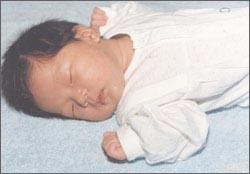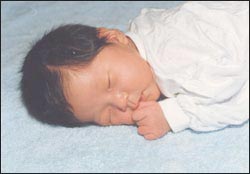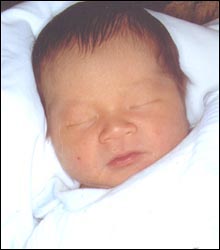소아청소년들의 하루 수면시간과 낮잠 자는 시간, Average sleeping hour and nap time daily
소아청소년들의 충분한 수면 Enough sleep for children and adolescents

사진 1-13. 충분한 수면은 정신 육체 건강을 최상으로 유지하는데 꼭 필요하다. 신생아들이나 초기 영아들을 재울 때 바닥에 등을 대고 눕혀 재운다.
Copyright ⓒ 2012 John Sangwon Lee, MD., FAAP

사진 1-14. 신생아들이나 초기 영아들을 재울 때 바닥에 배를 대고 엎어 눕혀 재우는 수면체위를 권장하지 않는다. 의식주 건강, 사랑, 수면은 인간에 가장 필요한 기본 조건들이다.
Copyright ⓒ 2012 John Sangwon Lee, MD., FAAP
-
개인, 나이, 환경, 생활양식 등에 따라 최상 건강을 유지하는데 필요한 하루 평균 총 수면시간은 정상적으로 조금씩 차이가 난다.
-
때문에 건강에 가장 좋은 하루 평균 총 수면시간은 나이, 성별, 생활양식 등에 따라 똑같을 수 없다.
-
태어나서 첫 4주까지 신생아기 대부분의 신생아들의 하루 평균 총 수면시간은 15~18시간이다. 다른 연구에 의하면 평균 20시간이다.
-
신생아기 아기들의 하루 일과는 먹고 대소변을 보고 자고 깨어 울고 놀고 자는 것이 전부인 것 같다.
-
어떤 신생아들은 잠자는 시간과 깨어 있는 시간이 확실히 분별되지 않는다.
-
생후 첫 4주 동안 신생아들의 “하루 24시간 밤과 낮 주기“가 정상적으로 일정치 않다.
-
생후 2~3개월 된 영아들의 대부분은 한 번 잠들면 3~5시간 동안 계속 자다가 깰 수 있고 그 후 한두 시간 동안 먹고 놀고 다시 자는 것이 보통이다.
-
생후 4~6개월이 되어야 비로소 거의 모든 영아들의 “하루 24시간 밤과 낮 주기“가 일정하게 된다.
-
이때부터 엄마아빠나 식구들의 “하루 24시간 밤과 낮 주기“에 따라 영유아들의 수면패턴도 결정된다. 엄마아빠 및 그 집안 식구들의 수면 패턴에 따라 영아들의 수면 패턴이 정해지고 그에 따라 잠을 잘 수 있다.
-
생후 3~15개월 된 영유아들의 하루 평균 총 수면 시간은 약 15시간이다.
표 1-1. 소아청소년들의 수면시간과 낮잠 자는 시간
| 수면 시간
나이 |
1일 총 수면 시간 | 한번 깨어있는 최장 시간 | 1회 자는 최장수면 시간 | 1일 낮잠 자는 횟수 | 최장 낮잠 자는 시간 |
| 신생아기 (생후 28일까지) | 15∼20시간 | 2시간 | 4시간 (3∼5시간) | – | – |
| 4개월 | 15∼20시간 | 2.5∼3.5시간 | 8.5시간 | – | – |
| 6개월 | 15∼18시간 | – | – | 2∼3회 | |
| 12개월 | 14∼16시간 | – | – | 1∼2회 | 1∼3시간 |
| 2세 | 12∼14시간 | – | – | 1∼2회 | 1∼3시간 |
| 2년 반 | 13시간 | – | – | – | – |
| 4∼5세 | 10∼12시간 | – | – | 주 3∼5회 | – |
| 10세 | 10시간 | – | – | – | – |
| 12세 | 9∼10시간 | – | – | – | – |
| 17세 | 8∼9시간 | – | – | – | – |
출처: Guide to your child and others
그 외
-
첫 돌이 되기 몇 개월 전부터 12~15세까지 1일 평균 총 수면시간이 점점 짧아지기 시작한다.
-
12~15세 사춘기 아이들의 1일 평균 총 수면시간은 9~10시간이다.
-
잠을 충분히 자지 못하면 마치 음식물을 충분히 섭취 못하고 엄마아빠의 사랑을 충분히 받지 못하고 자라는 소아 청소년과 같을 수 있다.
-
15~18세의 사춘기 아이들의 1일 평균 총 수면시간은 8~9시간 정도이다.
-
신생아들이나 영유아들의 수면 패턴은 다양하다.
-
생후 첫 몇 주 동안 대부분의 신생아들은 깨어 있는지 자고 있는지 확실히 분별할 수 없을 정도다. 대부분의 신생아들은 밤낮을 가리지 않고 자고 깨고 먹는 것이 정상 수면 패턴이다.
-
생후 2~3개월부터 대부분의 영아들은 밤낮을 어느 정도 가려 자고 깨는 식의 수면 패턴을 가질 수 있다.
-
생후 4~6개월부터 “하루 24시간 밤과 낮 주기“가 어느 정도 뚜렷해지기 시작한다.
-
어떤 신생아들이나 영아들은 밤중에는 조금씩 자고 낮 동안에는 많이 잔다.
-
어떤 신생아들이나 영아들은 낮에는 거의 자지 않고 밤에 주로 잔다.
-
어떤 영아들은 낮잠을 조금자고,
-
또 어떤 유아들은 낮잠을 거의 자지 않는다.
-
이와 같이 아이들의 잠자는 수면 패턴은 정상적으로 제 각각 다르고 다양하다.
-
1~2세까지 대부분의 타들러 영유아들은 그 날 그 날 필요로 하는 총 수면 량을 주로 밤에 취한다.
-
대부분의 유아들은 5살이 될 때까지 적어도 1일 1~3시간 동안 낮잠 잔다.
-
이와 같이 각 영유아에 따라 학령기 아이에 따라 잠자는 수면패턴이 다양하다.
-
그렇지만 아이들의 1일 평균 총 수면시간은 거의 비슷하다.
-
2, 3세 이후부터 낮잠을 전혀 자지 않는 유아들도 있다.
-
영유아들이 자다가 무서운 꿈을 꾸고 놀래 깰 수 있다.
-
정서적 문제나 정신적 문제나 육체적 질환으로 인해 잠을 충분히 자지 못할 수 있다.
-
특히 사춘기 아이가 잠을 쉽게 들 수 없거나, 잠을 충분히 자지 못하면 정신적으로나 육체적으로 어떤 문제가 있든지, 특히 우울증이 있는 징조일 수 있다. 그 원인을 빨리 알아서 적절히 치료받아야 한다.
-
소아청소년 자녀가 충분히 자는지, 수면 장애가 자녀에게 있는지 자주 점검해야한다.
-
수면 문제가 소아청소년 자녀에게 있으면 그 수면 문제를 조속히 적절히 해결해야 한다.
-
잠(수면)에 관해 더 많은 정보는 [부모도 반의사가 되어야 한다–소아가정간호 백과]-제 3권 신생아, 영유아, 학령기와 사춘기 아이의 성장발육, 제 12권 소아청소년 신경 정신, 정서, 행동, 심리. 수면 문제, 제 22권 아들 딸 이렇게 사랑해 키우세요 참조.

사진 1-15. 좋은 수면습관을 갖게 수면 훈련을 시키려면 신생아기부터 수면 훈련을 잘 시킨다. Copyright ⓒ 2012 John Sangwon Lee, MD., FAAP

사진 1-16. 영유아들은 잘 때 자기들이 좋아하는 장난감 곰 등 “과도기용 물체“를 안고자거나 옆에 놓고 잔다. Copyright ⓒ 2012 John Sangwon Lee, MD., FAAP
An average sleeping hour and nap time daily for children and adolescents,소아청소년들의 하루 수면시간과 낮잠 자는 시간
- Enough sleep for children and adolescents

Photo 1-13. Sufficient sleep is essential to maintaining the best mental and physical health. When sleeping newborns or early infants, lay them on their backs to sleep. Copyright ⓒ 2012 John Sangwon Lee, MD., FAAP

Photo 1-14. When sleeping newborns or early infants, it is not recommended to sleep on your stomach on the floor. Food, clothing, shelter, health, love, and sleep are the most necessary basic conditions for humans. Copyright ⓒ 2012 John Sangwon Lee, MD., FAAP
- Depending on the individual, age, environment, lifestyle, etc., the average total sleep time per day required to maintain optimal health varies slightly, normally.
- Therefore, the average total sleep time per day that is best for health cannot be the same depending on age, gender, and lifestyle.
- The average total sleep time per day for most newborns from birth until the first 4 weeks is 15-18 hours. According to other studies, it is an average of 20 hours.
- The daily routine of newborn babies seems to be all about eating, drinking, sleeping, waking up, crying, playing, and sleeping.
- In some newborns, the time to sleep and the time to be awake are clearly indistinguishable.
- During the first 4 weeks of life, newborns’ “24-hour night and day cycle” is not normally constant.
- Most of the infants aged 2-3 months after falling asleep can continue to sleep for 3 to 5 hours, then wake up, then eat for an hour or two, play, and sleep again.
- Only when they are 4-6 months old, the “24-hour night and day cycle” of almost all infants becomes constant.
- From this point on, the sleep patterns of infants and young children are also determined according to the “24 hours night and day cycle” of the mother, father, and family.
- The sleep patterns of infants are determined according to the sleep patterns of mothers and fathers and their family members, and they can sleep accordingly.
- The average total sleep time per day for infants and toddlers aged 3 to 15 months is about 15 hours.
Table 1-1. Sleep time and nap time for children and adolescents 표 1-1. 소아청소년들의 수면시간과 낮잠 자는 시간
| 수면 시간/
나이 Sleep time/ age |
1일 총 수면 시간
Total sleep time per day |
한번 깨어있는 최장 시간
Maximum time awake once |
1회 자는 최장수면 시간
Longest sleep time per day |
1일 낮잠 자는 횟수
Maximum number of naps per day |
최장 낮잠 자는 시간
Longest nap time |
| 신생아기 (생후 28일까지)
Newborn period (until the 28th day of age) |
15∼20 hours | 2 hours | 4 hours (3∼5 hours) | – | – |
| 4 months | 15∼20 hours | 2.5∼3.5 hours | 8.5 hours | – | – |
| 6 months | 15∼18 hours | – | – | 2∼3 times | |
| 12 months | 14∼16 hours | – | – | 1∼2 times | 1∼3 hours |
| 2 years old | 12∼14 hours | – | – | 1∼2 times | 1∼3 hours |
| 2 years old 6 months | 13 hours | – | – | – | – |
| 4∼5 years old | 10∼12 hours | – | – | 주 3∼5 times | – |
| 10 years old | 10 hours | – | – | – | – |
| 12 years old | 9∼10 hours | – | – | – | – |
| 17 years old | 8∼9 hours | – | – | – | – |
Source: Guide to your child and others etc
- From a few months before the first birthday to the age of 12-15, the average total sleep time per day starts to get shorter and shorter.
- The average total sleep time per day for adolescent children aged 12-15 years is 9-10 hours. If you don’t get enough sleep, it can be like a child or adolescent who doesn’t eat enough food and doesn’t get enough love from mom and dad.
- The average total sleep time per day for adolescent children aged 15 to 18 is about 8 to 9 hours. Sleep patterns in newborns and infants vary.
- During the first few weeks of life, most newborns are hardly able to tell whether they are awake or sleeping.
- Most newborns sleep, wake up, and eat at any time of the day or night, as their normal sleep pattern.
- From 2 to 3 months of age, most infants can have sleep patterns such as sleeping and waking up to some extent during the day and night.
- From the 4th to 6th months of age, the “24-hour night and day cycle” begins to become clear to some extent.
- Some newborns and infants sleep little during the night and a lot during the day. Some newborns or infants rarely sleep during the day and sleep mainly at night.
- Some infants take a little nap,
- Other infants rarely take a nap. In this way, children’s sleeping patterns are normally different and varied.
- Most infants and toddlers up to the age of 1 or 2 get the total amount of sleep they need that day, mainly at night.
- Most infants take a nap for at least 1 to 3 hours per day until they are 5 years old. In this way, sleeping patterns vary according to school-age children according to each infant.
- However, the average total sleep time per day for children is almost the same. Some infants do not take a nap at all from the age of 2 or 3.
- Infants and toddlers can wake up with scary dreams while sleeping.
- Emotional, mental, or physical problems can prevent them from getting enough sleep. In particular, if adolescents cannot fall asleep easily, or if they do not sleep enough,
- it can be a sign of any mental or physical problem, especially depression.
- The cause must be determined quickly and treated appropriately.
- Children and adolescents should be frequently checked to see if they are sleeping enough and if their children have sleep problems.
- If a child or adolescent has sleep problems, the sleep problems need to be addressed promptly and appropriately. For more information about sleep, see [Parents should also be at least the half-doctors-Encyclopedia of Child and Family Nursing]-Volume 3, Growth and Development of Newborns, Infants, and Adolescent Children, Volume 12 Pediatric and Adolescent Neuropsychiatric, Emotion, and Behavior,
- Psychology. Sleep problems, see Volume 22, Sons and Daughters, Love and Raise this way.

Photo 1-15. In order to train you to sleep to have good sleeping habits, do good sleep training from the newborn period. Copyright ⓒ 2012 John Sangwon Lee, MD., FAAP

Photo 1-16. When infants and toddlers sleep, they sleep with their favorite toy bears and other “transitional objects” or next to them. Copyright ⓒ 2012 John Sangwon Lee, MD., FAAP
출처 및 참조문헌
- www.drleepediatrics.com 제1권 소아청소년 응급 의료
- www.drleepediatrics.com 제2권 소아청소년 예방
- www.drleepediatrics.com 제3권 소아청소년 성장 발육 육아
- www.drleepediatrics.com 제4권 모유,모유수유, 이유
- www.drleepediatrics.com 제5권 인공영양, 우유, 이유식, 비타민, 미네랄, 단백질, 탄수화물, 지방
- www.drleepediatrics.com 제6권 신생아 성장 발육 육아 질병
- www.drleepediatrics.com제7권 소아청소년 감염병
- www.drleepediatrics.com제8권 소아청소년 호흡기 질환
- www.drleepediatrics.com제9권 소아청소년 소화기 질환
- www.drleepediatrics.com제10권. 소아청소년 신장 비뇨 생식기 질환
- www.drleepediatrics.com제11권. 소아청소년 심장 혈관계 질환
- www.drleepediatrics.com제12권. 소아청소년 신경 정신 질환, 행동 수면 문제
- www.drleepediatrics.com제13권. 소아청소년 혈액, 림프, 종양 질환
- www.drleepediatrics.com제14권. 소아청소년 내분비, 유전, 염색체, 대사, 희귀병
- www.drleepediatrics.com제15권. 소아청소년 알레르기, 자가 면역질환
- www.drleepediatrics.com제16권. 소아청소년 정형외과 질환
- www.drleepediatrics.com제17권. 소아청소년 피부 질환
- www.drleepediatrics.com제18권. 소아청소년 이비인후(귀 코 인두 후두) 질환
- www.drleepediatrics.com제19권. 소아청소년 안과 (눈)질환
- www.drleepediatrics.com 제 20권 소아청소년 이 (치아)질환
- www.drleepediatrics.com 제21권 소아청소년 가정 학교 간호
- Red book 29th-31st edition 2021
- Nelson Text Book of Pediatrics 19th- 21st Edition
- The Johns Hopkins Hospital, The Harriet Lane Handbook, 22nd edition
- Childhood Emergencies in the Office, Hospital and Community, American Academy of Pediatrics
- Emergency Medical Service for Children, By Ross Lab. May 1989. p.10
- Emergency care, Harvey Grant and Robert Murray
- Emergency Care Transportation of Sick and Injured American Academy of Orthopedic Surgeons
- Emergency Pediatrics A Guide to Ambulatory Care, Roger M. Barkin, Peter Rosen
- Immediate care of the acutely ill and injured, Hugh E. Stephenson, Jr
- The Critically Ill Child, Diagnosis and Management, Edited by Clement A. Smith
- Emergency Medical Services for Children: The Role of the Primary Care Provider, America Academy of Pediatrics
- Quick Reference To Pediatric Emergencies , Delmer J. Pascoe, M.D., Moses Grossman, M.D. with 26 contributors
- Manual of Emergency Care
- 응급환자관리 정담미디어
- 소아가정간호백과–부모도 반의사가 되어야 한다, 이상원
- Neonatal Resuscitation American heart Association
- Neonatology Jeffrey J.Pomerance, C. Joan Richardson
- Pediatric Resuscitation Pediatric Clinics of North America, Stephen M. Schexnayder, M.D.
- Pediatric Critical Care, Pediatric Clinics of North America, James P. Orlowski, M.D.
- Preparation for Birth. Beverly Savage and Dianna Smith
- Infectious disease of children, Saul Krugman, Samuel L Katz, Ann A. Gerhon, Catherine Wilfert
- The Harriet Lane Handbook 19th Edition
- 소아과학 대한교과서
- 제1권 소아청소년 응급의료 참조문헌과 출처
- 제2권 소아청소년 질병․안전사고 예방 참조문헌과 출처
- Other
Copyright ⓒ 2015 John Sangwon Lee, MD., FAAP
“부모도 반의사가 되어야 한다”-내용은 여러분들의 의사로부터 얻은 정보와 진료를 대신할 수 없습니다.
“The information contained in this publication should not be used as a substitute for the medical care and advice of your doctor. There may be variations in treatment that your doctor may recommend based on individual facts and circumstances. “Parental education is the best medicine.”